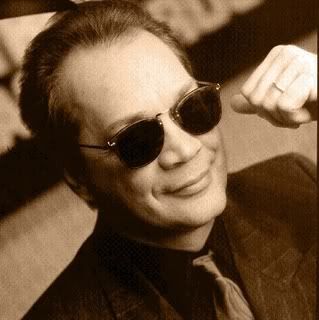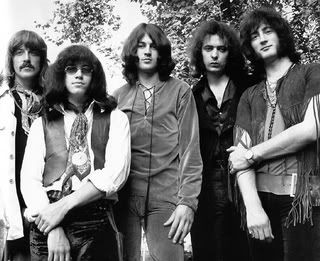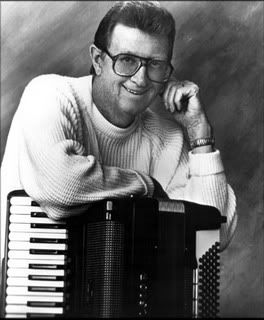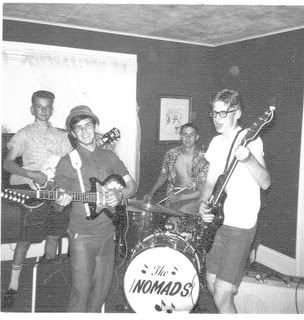
The Nomads
By STEVE SEYMOUR
In the early 1960s, when country combos dominated the local scene and before the Beatles-led British Invasion sparked an explosion of new bands, Escanaba spawned its first rock group.
The Nomads filled a growing demand for live rock music and enjoyed a "pretty good following" among the area's young people, according to group member Hank Mroczkowski.
Formed in the fall of 1963, the Nomads consisted of Mroczkowski on sax and bass, younger brother Corky on lead guitar, Tony Romani on vocals and rhythm guitar, and drummer Mike LeMire.
Their first job was a dance at the Multi-Purpose Room at Holy Name High School, where Romani and LeMire were enrolled as sophomores, while Hank was a freshman. Corky was an eighth grader at the Junior High School. For the occasion, the group donned formal attire, including vests and skinny ties.
Vocalist Romani was a Cuban refugee, who moved here with his brother George. He had a noticeable Spanish accent, but was a talented singer who had a good rapport with an audience eager to hear the group recreate the hits of the day.
The Nomads, named by drummer LeMire, enjoyed increasing success in the coming months as demand for rock music grew following the assassination of President Kennedy and the arrival of the Beatles, bringing rock music to the forefront of public consciousness.
Hank recalled the band being paid $100-- $25 per man-- for a three hour show. The American Federation of Musicians Local 663 at the time mandated a fee of $8 per person for such engagements. The pay looked particularly attractive to Hank compared to the 80 cents an hour he was making while working at Mel & Elmer's Super Valu during the same period.
Despite the success of the Nomads, when his father booked a job for his polka band, called My Three Sons, Hank still handled accordion duties at the family gig even if there was a conflict with the Nomads schedule. "We played a lot of Polish weddings," Hank recalled of the band which also included Corky and their brother Dale.
The Nomads, meanwhile, played numerous school dances as well as gigs in Iron Mountain and Manistique. In July, 1964 they played a show at Pioneer Trail Park, dressed in sharp light blue suits with the group's name displayed prominently on LeMire's drumkit, surrounded by musical notes.
At the time, the Nomads owned two amps, three guitars, two mics and a drum set. Because they didn't have a public address system, the microphones were plugged directly into the amplifiers. Frank Wandahsega hauled their equipment and was involved with set-up and tear-down as well as being the band's "bouncer."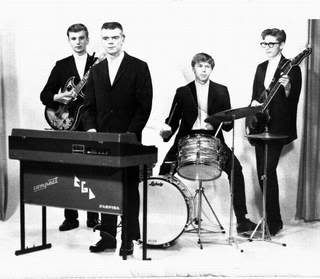
Beat Inc.
By 1965 however, the Mroczkowski brothers had joined with drummer Jim Lewis and keyboardist Bruce Douglas to form Beat Inc. The name reflected the Beatles' influence in pop music, while Inc. was borrowed from Sounds Incorporated, which had opened some shows for John, Paul, George and Ringo on a world tour. "We just put the names together," Hank recalled.
Playing with Lewis was nothing new for Hank. A few years earlier they were in a folk duo which became the Brimstone Trio with the addition of Barb Frasher.
One of the earliest shows Beat Inc. performed was the homecoming dance at Escanaba Area Public High School on Saturday, Oct. 2, 1965. Admission was 50 cents.
Reflecting the music tastes of the period, the newly formed Beat Inc. played songs by the Beatles, Rolling Stones, Kinks, Dave Clark 5, Gerry and the Pacemakers and Herman's Hermits.
To promote themselves, the band had a professional photograph taken at Preston's House of Portraits, 801 lst Ave. S.
The band, which did not have a manager, booked themselves into Skinny's Bar, 1837 3rd Ave. N., while one of their biggest gigs was opening for Sam the Sham and the Pharaohs during shows in Green Bay and Escanaba in 1966. "We played at various local places, mostly at dance halls and schools," Douglas, now a Minneapolis resident, said. "We had a pretty regular gig at the American Legion Hall in Powers. We also did weddings and such.
"Corky was a good trumpet player as well as guitarist. Hank played just about everything, sax, bass, drums, accordion, whatever. I just played Farfisa organ. I believe there were times when Jim would play acoustic and Hank would play drums," Douglas recalled.
At one point, Beat Inc. was scheduled to perform on a March of Dimes telethon on WLUC-TV6, in Marquette but fate intervened that January day. Douglas remembers: "Jim, Corky and I were sitting in the front seat of Jim's car. Near Kipling, Jim reached to get something in the back seat and lost control of the car. It went off the road and hit a tree and then a school house. I was struck in the back of the head with a snare drum and ruined my jacket. Got blood all over it. I woke up in the ambulance with Corky sitting next to me. I remember he looked very concerned. Jim's car was totaled.
"Hank was following behind us. My organ got smashed but insurance paid for a new one. I spent a couple of days in the hospital," Douglas recounted. In addition, "Jim was pretty banged up," Hank said.
As was the case at the time, rock groups formed and broke-up, often staying together only a brief time. Beat Inc. evolved into John Evil and the Spirits in 1967, with the addition of frontman John Bergquist, who handled vocal duties. "He was pretty good, did stuff like Tom Jones and rock artists," Douglas said.
But, that's another story.
